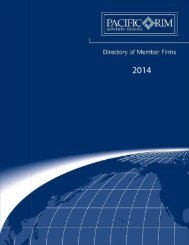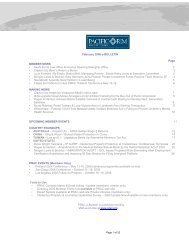3.3.8 DisclaimersTheir use <strong>in</strong> an <strong>in</strong>formation memorandumAn <strong>in</strong>formation memorandum almost always conta<strong>in</strong>s a detaileddisclaimer <strong>of</strong> liability. This is usually found <strong>in</strong> <strong>the</strong> ImportantNotice section at <strong>the</strong> front <strong>of</strong> <strong>the</strong> <strong>in</strong>formation memorandum.Disclaimers vary <strong>in</strong> <strong>the</strong>ir language, but usually fall <strong>in</strong><strong>to</strong> one <strong>of</strong>two classes:• <strong>of</strong>ten, but not always, <strong>the</strong> <strong>in</strong>formation memorandum conta<strong>in</strong>san express denial <strong>of</strong> liability <strong>in</strong> respect <strong>of</strong> representations orstatements conta<strong>in</strong>ed <strong>in</strong> it.• usually <strong>in</strong>ves<strong>to</strong>rs will be directed <strong>to</strong> make and rely upon <strong>the</strong>irown <strong>in</strong>quiries <strong>in</strong> relation <strong>to</strong> <strong>the</strong> securities on <strong>of</strong>fer.Disclaimers as a means <strong>of</strong> avoid<strong>in</strong>g a contraventionIt is clear that a disclaimer cannot oust section 52 <strong>of</strong> <strong>the</strong> TPA(and presumably sections 1041H <strong>of</strong> <strong>the</strong> Corporations Act and12DA <strong>of</strong> <strong>the</strong> ASIC Act). Where a person engages <strong>in</strong> mislead<strong>in</strong>gor deceptive conduct through a defective <strong>in</strong>formationmemorandum, a disclaimer as <strong>in</strong> <strong>the</strong> first disclaimer above, willbe <strong>in</strong>effective.Us<strong>in</strong>g disclaimers <strong>to</strong> elim<strong>in</strong>ate relianceSections 1041I <strong>of</strong> <strong>the</strong> Corporations Act and 12GF <strong>of</strong> <strong>the</strong> ASIC Acteach require that a pla<strong>in</strong>tiff establish a causal connectionbetween <strong>the</strong> mislead<strong>in</strong>g and deceptive conduct and <strong>the</strong> lossclaimed (“loss or damage by conduct <strong>of</strong> ano<strong>the</strong>r person”).The second class <strong>of</strong> disclaimer referred <strong>to</strong> above seeks <strong>to</strong>elim<strong>in</strong>ate <strong>the</strong> causal connection between <strong>the</strong> mislead<strong>in</strong>g ordeceptive conduct and <strong>the</strong> alleged damage, by advis<strong>in</strong>g <strong>in</strong>tend<strong>in</strong>g<strong>in</strong>ves<strong>to</strong>rs that <strong>the</strong>y must not rely on <strong>the</strong> <strong>in</strong>formationmemorandum.Although <strong>the</strong>re are some authorities <strong>in</strong> support <strong>of</strong> <strong>the</strong> secondclass <strong>of</strong> disclaimer, a consistent and uniform judicial approachhas yet <strong>to</strong> emerge on this issue. It is likely that <strong>the</strong> courts wouldbe more prepared <strong>to</strong> uphold such a disclaimer where <strong>the</strong>recipient, as with a capital markets issue, is sophisticated.However, it is equally likely that a court’s approach will also be<strong>in</strong>fluenced by its assessment <strong>of</strong> how practical it would have beenfor an <strong>in</strong>ves<strong>to</strong>r <strong>to</strong> rely on its own <strong>in</strong>quiries. If <strong>the</strong> court takes <strong>the</strong>view that an <strong>in</strong>ves<strong>to</strong>r could not have reasonably implemented <strong>the</strong>direction <strong>in</strong> <strong>the</strong> disclaimer, <strong>the</strong>n it probably will not give effect <strong>to</strong>its terms.3.4 ConclusionThe Corporations Act and <strong>the</strong> ASIC Act (and o<strong>the</strong>r similarlegislation) impose substantial civil consequences on thoseresponsible for <strong>the</strong> preparation <strong>of</strong> a defective <strong>in</strong>formationmemorandum. Securitisers need <strong>to</strong> be particularly m<strong>in</strong>dful <strong>of</strong><strong>the</strong>se and <strong>to</strong> <strong>in</strong>stitute procedures for <strong>the</strong> preparation <strong>of</strong> an<strong>in</strong>formation memorandum <strong>in</strong> a systematic manner <strong>to</strong> ensure itscompleteness and accuracy. It is only by <strong>the</strong>se means that <strong>the</strong>risks for securitisers from defective <strong>in</strong>formation memorandumswill be m<strong>in</strong>imised.The next two sections <strong>of</strong> this publication deal with some <strong>of</strong> <strong>the</strong>revenue impacts on securitisation. These are stamp duty (section4) and tax (section 5).23
4 Stamp duty and securitisation244.1 IntroductionThere is a potential for stamp duty <strong>to</strong> be levied on several stages<strong>of</strong> a typical securitisation. These <strong>in</strong>clude <strong>the</strong> declarations <strong>of</strong> trust(for trust securitisations) and <strong>the</strong> security trust, <strong>the</strong> transfer <strong>of</strong>assets <strong>in</strong><strong>to</strong> <strong>the</strong> securitisation vehicle, <strong>the</strong> grant <strong>of</strong> a charge over<strong>the</strong> assets <strong>of</strong> <strong>the</strong> securitisation vehicle <strong>in</strong> favour <strong>of</strong> <strong>the</strong> securitytrustee and <strong>the</strong> issue and transfer <strong>of</strong> <strong>the</strong> securitised <strong>in</strong>struments.Most securitisations would not be economically feasible if advalorem duty was imposed at any <strong>of</strong> <strong>the</strong>se po<strong>in</strong>ts. Accord<strong>in</strong>gly, itis important <strong>to</strong> structure securitisations so that <strong>the</strong>y do notattract duty at any stage <strong>of</strong> <strong>the</strong> process. This task is made morecomplex as stamp duty is a State-based tax and <strong>the</strong> relevantlegislation differs from jurisdiction <strong>to</strong> jurisdiction.Time and space do not permit a detailed analysis <strong>of</strong> <strong>the</strong> stampduty position as it applies throughout <strong>Australia</strong>.Given <strong>the</strong> central importance <strong>of</strong> <strong>the</strong> New South Wales DutiesAct, this section will concentrate on <strong>the</strong> New South Walesstamp duty position under that Act. One or two comments will,though, be made on <strong>the</strong> position <strong>in</strong> o<strong>the</strong>r States and Terri<strong>to</strong>ries.4.2 Duties Act: General overviewThe underly<strong>in</strong>g <strong>in</strong>tention <strong>in</strong> draft<strong>in</strong>g <strong>the</strong> Duties Act was <strong>to</strong>rewrite <strong>the</strong> Stamp Duties Act 1920 (<strong>the</strong> 1920 Act) <strong>in</strong> a simpler,more contemporary style and <strong>to</strong> facilitate harmonisation with <strong>the</strong>o<strong>the</strong>r jurisdictions participat<strong>in</strong>g <strong>in</strong> <strong>the</strong> project.Various policy changes were also made. They <strong>in</strong>cluded <strong>the</strong>follow<strong>in</strong>g which are relevant <strong>to</strong> securitisation:• “debentures” are no longer dutiable as loan securities. Loansecurities are only dutiable if <strong>the</strong>y are mortgages or chargesover property and <strong>the</strong> property is located, or deemed <strong>to</strong> belocated, <strong>in</strong> New South Wales.• <strong>the</strong> conveyance head <strong>of</strong> duty, which applied <strong>to</strong> any property <strong>in</strong>New South Wales, was replaced with a regime levy<strong>in</strong>g <strong>the</strong>same rates <strong>of</strong> duty <strong>in</strong> respect <strong>of</strong> any “transfer <strong>of</strong> dutiableproperty”.A “transfer” is effectively def<strong>in</strong>ed <strong>in</strong> section 8 <strong>of</strong> <strong>the</strong> Duties Act<strong>to</strong> <strong>in</strong>clude “an agreement for sale, an agreement for transfer, adeclaration <strong>of</strong> trust or any one <strong>of</strong> certa<strong>in</strong> limited classes <strong>of</strong>transaction affect<strong>in</strong>g dutiable property”.“Dutiable property” <strong>in</strong> turn is def<strong>in</strong>ed <strong>in</strong> section 11 <strong>to</strong> <strong>in</strong>clude <strong>the</strong>follow<strong>in</strong>g:– land, transferable floor space or a land use entitlement;– shares not quoted on <strong>the</strong> s<strong>to</strong>ck exchange;– units <strong>in</strong> a unit trust scheme;– good will, <strong>in</strong>tellectual property and Commonwealth statu<strong>to</strong>rylicences exploited with<strong>in</strong> <strong>the</strong> 12 month period prior <strong>to</strong> <strong>the</strong>transaction;– New South Wales statu<strong>to</strong>ry licences or permissions;– partnership <strong>in</strong>terests;– goods, if those goods are subject <strong>to</strong> a dutiable transactionalong with any o<strong>the</strong>r dutiable property, o<strong>the</strong>r than <strong>in</strong>tellectualproperty; <strong>the</strong>re is a carve out for s<strong>to</strong>ck <strong>in</strong> trade;– an option <strong>to</strong> purchase land;– an <strong>in</strong>terest <strong>in</strong> any dutiable property except <strong>to</strong> <strong>the</strong> extent that:– it arises as a consequence <strong>of</strong> <strong>the</strong> ownership <strong>of</strong> a unit <strong>in</strong> aunit trust scheme and is not a land use entitlement; or– it is attributable <strong>to</strong> an option over dutiable property.Significantly, most f<strong>in</strong>ancial assets are not dutiable property andso fall outside <strong>the</strong> reach <strong>of</strong> <strong>the</strong> transfer head <strong>of</strong> duty. (In thisregard, section 65(1)(d) reta<strong>in</strong>s an express exemption fortransfers <strong>of</strong> mortgages or declarations <strong>of</strong> trust over mortgages <strong>of</strong>dutiable property.)If a transfer <strong>of</strong> dutiable property occurs, it does not matterwhe<strong>the</strong>r or not that transfer is effected by a written <strong>in</strong>strument.If it is not effected by a written <strong>in</strong>strument, a statement must belodged and duty must be paid on that statement.4.3 Creation <strong>of</strong> a securitisation trustThe majority <strong>of</strong> securitised structures <strong>in</strong>volve <strong>the</strong> creation <strong>of</strong> atrust.Declarations <strong>of</strong> trust, whe<strong>the</strong>r or not <strong>the</strong>y are <strong>in</strong> writ<strong>in</strong>g, attractad valorem transfer duty <strong>of</strong> up <strong>to</strong> 5.5 percent <strong>of</strong> <strong>the</strong> value <strong>of</strong> <strong>the</strong>dutiable property <strong>the</strong> subject <strong>of</strong> <strong>the</strong> trust. For <strong>the</strong> reasonsreferred <strong>to</strong> <strong>in</strong> section 4.2, this duty will have little impact onsecuritisations as, generally speak<strong>in</strong>g, <strong>the</strong> assets which are <strong>the</strong>subject <strong>of</strong> <strong>the</strong> trust are not dutiable property.Nom<strong>in</strong>al duty may still be payable on a declaration <strong>of</strong> trust for asecuritisation. If a declaration <strong>of</strong> trust is made <strong>in</strong> writ<strong>in</strong>g andsigned <strong>in</strong> New South Wales it will attract duty <strong>of</strong> $200 providedit declares a trust over property which is not dutiable property(see section 58(1)). Duty <strong>of</strong> $200 is also payable where noproperty is identified <strong>in</strong> <strong>the</strong> trust <strong>in</strong>strument, but <strong>the</strong> <strong>in</strong>strumentis executed <strong>in</strong> New South Wales (see section 58(2)).






